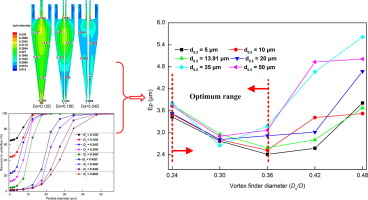当前位置:
X-MOL 学术
›
Powder Technol.
›
论文详情
Our official English website, www.x-mol.net, welcomes your
feedback! (Note: you will need to create a separate account there.)
Effects of Feed Size Distribution on Separation Performance of Hydrocyclones with Different Vortex Finder Diameters
Powder Technology ( IF 4.5 ) Pub Date : 2017-12-01 , DOI: 10.1016/j.powtec.2017.09.010 Baoyu Cui , Caie Zhang , Dezhou Wei , Shuaishuai Lu , Yuqing Feng
Powder Technology ( IF 4.5 ) Pub Date : 2017-12-01 , DOI: 10.1016/j.powtec.2017.09.010 Baoyu Cui , Caie Zhang , Dezhou Wei , Shuaishuai Lu , Yuqing Feng

|
Abstract Interactions between feed size distribution and separation performance for hydrocyclones with different vortex finder diameters (Do) are crucial for hydrocyclone designs but not clearly understood. In this work, the optimum range of Do is numerically confirmed for a 50 mm diameter hydrocyclone using computational fluid dynamics. Furthermore, effects of feed size distribution (FSD) on separation performance for hydrocyclones with different Do are discussed. For a given FSD, the lower limit of Do can be determined from the flow stability characterized by lower turbulence intensity and larger tangential velocity. Below the lower limit, a large proportion of fine particles report to the underflow. The upper limit can be determined from separation performance. Above the upper limit recovery to the underflow for coarse particles decreases drastically, which is caused by an outward shift of the locus of zero vertical velocity (LZVV) and an inward shift of particles equilibrium radius. For a given Do, FSD has no significant effects on partition curves when Do is in the optimum range. When Do is above the optimum range, both recovery to underflow for coarse particles and separation sharpness are decreased as the feed median size increases. In summary, when Do is in the optimum range, the hydrocyclone can adapt to different FSD to obtain the expected cut size by self-adjusting the LZVV and particles equilibrium radius. This method for determining the optimum range of Do is based on flow pattern characteristics and can be used as a universal tool for hydrocyclone design.
中文翻译:

进料粒度分布对不同旋流器直径水力旋流器分离性能的影响
摘要 具有不同涡流探测器直径 (Do) 的水力旋流器的进料粒度分布和分离性能之间的相互作用对于水力旋流器设计至关重要,但尚不清楚。在这项工作中,使用计算流体动力学对直径为 50 毫米的水力旋流器的 Do 的最佳范围进行了数值确认。此外,还讨论了进料粒度分布 (FSD) 对不同 Do 的水力旋流器分离性能的影响。对于给定的 FSD,Do 的下限可以从以较低湍流强度和较大切向速度为特征的流动稳定性确定。低于下限,大部分细颗粒报告到底流。上限可由分离性能确定。高于上限时,粗颗粒的底流恢复急剧下降,这是由零垂直速度 (LZVV) 轨迹向外移动和颗粒平衡半径向内移动造成的。对于给定的 Do,当 Do 在最佳范围内时,FSD 对分区曲线没有显着影响。当 Do 高于最佳范围时,粗颗粒的底流回收率和分离锐度都随着进料中值粒径的增加而降低。综上所述,当Do在最佳范围内时,水力旋流器可以通过自调整LZVV和颗粒平衡半径来适应不同的FSD以获得预期的切割尺寸。这种确定 Do 最佳范围的方法基于流型特征,可用作水力旋流器设计的通用工具。这是由零垂直速度 (LZVV) 轨迹的外移和粒子平衡半径的内移引起的。对于给定的 Do,当 Do 在最佳范围内时,FSD 对分区曲线没有显着影响。当 Do 高于最佳范围时,粗颗粒的底流回收率和分离锐度都随着进料中值粒径的增加而降低。综上所述,当Do在最佳范围内时,水力旋流器可以通过自调整LZVV和颗粒平衡半径来适应不同的FSD以获得预期的切割尺寸。这种确定 Do 最佳范围的方法基于流型特征,可用作水力旋流器设计的通用工具。这是由零垂直速度 (LZVV) 轨迹的外移和粒子平衡半径的内移引起的。对于给定的 Do,当 Do 在最佳范围内时,FSD 对分区曲线没有显着影响。当 Do 高于最佳范围时,粗颗粒的底流回收率和分离锐度都随着进料中值粒径的增加而降低。综上所述,当Do在最佳范围内时,水力旋流器可以通过自调整LZVV和颗粒平衡半径来适应不同的FSD以获得预期的切割尺寸。这种确定 Do 最佳范围的方法基于流型特征,可用作水力旋流器设计的通用工具。当 Do 在最佳范围内时,FSD 对分区曲线没有显着影响。当 Do 高于最佳范围时,粗颗粒的底流回收率和分离锐度都随着进料中值粒径的增加而降低。综上所述,当Do在最佳范围内时,水力旋流器可以通过自调整LZVV和颗粒平衡半径来适应不同的FSD以获得预期的切割尺寸。这种确定 Do 最佳范围的方法基于流型特征,可用作水力旋流器设计的通用工具。当 Do 在最佳范围内时,FSD 对分区曲线没有显着影响。当 Do 高于最佳范围时,粗颗粒的底流回收率和分离锐度都随着进料中值粒径的增加而降低。综上所述,当Do在最佳范围内时,水力旋流器可以通过自调整LZVV和颗粒平衡半径来适应不同的FSD以获得预期的切割尺寸。这种确定 Do 最佳范围的方法基于流型特征,可用作水力旋流器设计的通用工具。水力旋流器可以适应不同的FSD,通过自我调整LZVV和颗粒平衡半径来获得预期的切割尺寸。这种确定 Do 最佳范围的方法基于流型特征,可用作水力旋流器设计的通用工具。水力旋流器可以适应不同的FSD,通过自我调整LZVV和颗粒平衡半径来获得预期的切割尺寸。这种确定 Do 最佳范围的方法基于流型特征,可用作水力旋流器设计的通用工具。
更新日期:2017-12-01
中文翻译:

进料粒度分布对不同旋流器直径水力旋流器分离性能的影响
摘要 具有不同涡流探测器直径 (Do) 的水力旋流器的进料粒度分布和分离性能之间的相互作用对于水力旋流器设计至关重要,但尚不清楚。在这项工作中,使用计算流体动力学对直径为 50 毫米的水力旋流器的 Do 的最佳范围进行了数值确认。此外,还讨论了进料粒度分布 (FSD) 对不同 Do 的水力旋流器分离性能的影响。对于给定的 FSD,Do 的下限可以从以较低湍流强度和较大切向速度为特征的流动稳定性确定。低于下限,大部分细颗粒报告到底流。上限可由分离性能确定。高于上限时,粗颗粒的底流恢复急剧下降,这是由零垂直速度 (LZVV) 轨迹向外移动和颗粒平衡半径向内移动造成的。对于给定的 Do,当 Do 在最佳范围内时,FSD 对分区曲线没有显着影响。当 Do 高于最佳范围时,粗颗粒的底流回收率和分离锐度都随着进料中值粒径的增加而降低。综上所述,当Do在最佳范围内时,水力旋流器可以通过自调整LZVV和颗粒平衡半径来适应不同的FSD以获得预期的切割尺寸。这种确定 Do 最佳范围的方法基于流型特征,可用作水力旋流器设计的通用工具。这是由零垂直速度 (LZVV) 轨迹的外移和粒子平衡半径的内移引起的。对于给定的 Do,当 Do 在最佳范围内时,FSD 对分区曲线没有显着影响。当 Do 高于最佳范围时,粗颗粒的底流回收率和分离锐度都随着进料中值粒径的增加而降低。综上所述,当Do在最佳范围内时,水力旋流器可以通过自调整LZVV和颗粒平衡半径来适应不同的FSD以获得预期的切割尺寸。这种确定 Do 最佳范围的方法基于流型特征,可用作水力旋流器设计的通用工具。这是由零垂直速度 (LZVV) 轨迹的外移和粒子平衡半径的内移引起的。对于给定的 Do,当 Do 在最佳范围内时,FSD 对分区曲线没有显着影响。当 Do 高于最佳范围时,粗颗粒的底流回收率和分离锐度都随着进料中值粒径的增加而降低。综上所述,当Do在最佳范围内时,水力旋流器可以通过自调整LZVV和颗粒平衡半径来适应不同的FSD以获得预期的切割尺寸。这种确定 Do 最佳范围的方法基于流型特征,可用作水力旋流器设计的通用工具。当 Do 在最佳范围内时,FSD 对分区曲线没有显着影响。当 Do 高于最佳范围时,粗颗粒的底流回收率和分离锐度都随着进料中值粒径的增加而降低。综上所述,当Do在最佳范围内时,水力旋流器可以通过自调整LZVV和颗粒平衡半径来适应不同的FSD以获得预期的切割尺寸。这种确定 Do 最佳范围的方法基于流型特征,可用作水力旋流器设计的通用工具。当 Do 在最佳范围内时,FSD 对分区曲线没有显着影响。当 Do 高于最佳范围时,粗颗粒的底流回收率和分离锐度都随着进料中值粒径的增加而降低。综上所述,当Do在最佳范围内时,水力旋流器可以通过自调整LZVV和颗粒平衡半径来适应不同的FSD以获得预期的切割尺寸。这种确定 Do 最佳范围的方法基于流型特征,可用作水力旋流器设计的通用工具。水力旋流器可以适应不同的FSD,通过自我调整LZVV和颗粒平衡半径来获得预期的切割尺寸。这种确定 Do 最佳范围的方法基于流型特征,可用作水力旋流器设计的通用工具。水力旋流器可以适应不同的FSD,通过自我调整LZVV和颗粒平衡半径来获得预期的切割尺寸。这种确定 Do 最佳范围的方法基于流型特征,可用作水力旋流器设计的通用工具。











































 京公网安备 11010802027423号
京公网安备 11010802027423号